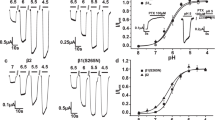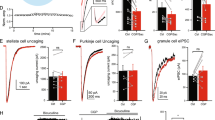Abstract
MAMMALIAN neurons contain at least three types of excitatory amino-acid receptors, selectively activated by N-methyl-D-aspar-tate (NMDA) or aspartate, (S)-α-amino-3-hydroxy-5-methyl-4-isoxazole proprionate ((S)-AMPA) and kainate1. An important aspect of NMDA receptors is their regulation by a variety of factors such as glycine2, Mg2+ (refs. 3,4) and Zn2+ (refs 5,6) that are present in vivo. We show here that NMDA receptor responses are selectively inhibited by protons, with a 50% inhibitory concentration (IC50) that is close to physiological pH, implying that NMDA receptors are not fully active under normal conditions. (S)-AMPA and kainate responses remain unchanged at similar pH levels. Proton inhibition is voltage-insensitive and does not result either from fast channel block, a change in channel conductance, or an increase in the 50% excitatory concentration (EC50) of aspartate/NMDA or glycine. Instead, protons seem to decrease markedly the opening frequency of 30–50 pS NMDA channels, and reduce the relative proportion of longer bursts. This feature of NMDA receptors could be relevant to neurotoxic activation of NMDA receptors during ischaemia7, as well as to seizure generation, as extracellular proton changes occur during both of these pathological situations8,9. Furthermore, these results may have implications for normal NMDA receptor function as transient changes in extracellular protons occur during synaptic transmission8,10.
This is a preview of subscription content, access via your institution
Access options
Subscribe to this journal
Receive 51 print issues and online access
$199.00 per year
only $3.90 per issue
Buy this article
- Purchase on Springer Link
- Instant access to full article PDF
Prices may be subject to local taxes which are calculated during checkout
Similar content being viewed by others

References
Watkins, J. C. & Evans, R. H. A. Rev. Pharmacol. Toxicol. 21, 165–204 (1981).
Johnson, J. W. & Ascher, P. Nature 325, 529–531 (1987).
Mayer, M. L., Westbrook, G. L. & Guthrie, P. B. Nature 309, 261–263 (1984).
Nowak, L., Bregestovski, P., Ascher, P., Herbet, A. & Prochiantz, A. Nature 307, 462–465 (1984).
Peters, S., Koh, J. & Choi, D. W. Science 236, 589–593 (1987).
Mayer, M. L., Vyklicky, L. & Westbrook, G. L. J. Physiol. 415, 329–350 (1989).
Dingledine, R. et al. CRC Critical Rev. Neurobiol. 4, 1–96 (1988).
Chesler, M. & Chan, C. Y. Neuroscience 27, 941–948 (1988).
Balestrino, M. & Somjen, G. G. J. Physiol. Lond. 396, 247–266 (1988).
Kraig, R. P., Ferreira-Filho, C. R. & Nicholson, C. J. Neurophysiol. 49, 831–850 (1983).
Krishtal, O. A., Osipchuk, Y. V., Shelest, T. N. & Smirnoff, S. V. Brain Res. 436, 352–356 (1987).
Maycox, P. R., Deckwerth, T., Hell, J. W. & Jahn, R. J. biol. Chem. 263, 15423–15428 (1988).
Cidon, S. & Sihra, T. S. J. biol. Chem. 264, 8281–8288 (1989).
Grantyn, R. & Lux, H. D. Neurosci. Lett. 89, 198–203 (1989).
Gruol, D. L., Barker, J. L., Huang, L.-Y. M., MacDonald, J. F. & Smith, T. G. Brain Res. 183, 247–252 (1980).
Tang, C. M., Dichter, M. & Morad, M. Soc. Neurosci. Abstr. 15, 326 (1989).
Morad, M., Dichter, M. & Tang, C. M. Soc. Neurosci. Abstr. 14, 791 (1988).
Hamill, O. P., Marty, A., Neher, E., Sakmann, B. & Sigworth, F. J. Pflugers Archlv. 391, 85–100 (1981).
Pietrobon, D., Prod'hom, B. & Hess, P. Nature 333, 373–376 (1988).
Cull-Candy, S. G., Howe, J. R. & Ogden, D. C. J. Physiol., Lond. 400, 189–222 (1988).
Cull-Candy, S. G. & Usowicz, M. M. Nature 325, 525–528 (1987).
Jahr, C. E. & Stevens, C. F. Nature 325, 522–525 (1987).
Howe, J. R., Colquhoun, D. & Cull-Candy, S. G. Proc. R. Soc. B233, 407–422 (1988).
Mutch, W. A. C. & Hansen, A. J. J. Cereb. Blood Flow Metab. 4, 17–27 (1984).
Giffard, R. G., Monyer, H., Christine, C. W. & Choi, D. W. Brain Res. 506, 339–342 (1990).
Kleckner, N. W. & Dingledine, R. Science 241, 835–837 (1988).
MacDonald, J. F., Mody, I. & Salter, M. W. J. Physiol. 414, 17–34 (1989).
Krishtal, O. A. & Pidoplichko, V. I. Neuroscience 5, 2325–2327 (1980).
Colquhoun, D. & Sigworth, F. J. in Single Channel Recording (eds Sakmann, B. & Neher, E. 191–263 (New York, Plenum, 1983).
Patlak, J. B. J. gen. Physiol. 92, 413–430 (1988).
Author information
Authors and Affiliations
Rights and permissions
About this article
Cite this article
Traynelis, S., Cull-Candy, S. Proton inhibition of N-methyl-D-aspartate receptors in cerebellar neurons. Nature 345, 347–350 (1990). https://doi.org/10.1038/345347a0
Received:
Accepted:
Issue Date:
DOI: https://doi.org/10.1038/345347a0
This article is cited by
-
Selective Reduction of Ca2+ Entry Through the Human NMDA Receptor: a Quantitative Study by Simultaneous Ca2+ and Na+ Imaging
Molecular Neurobiology (2024)
-
Inhibition of NMDA receptors through a membrane-to-channel path
Nature Communications (2022)
-
Anticonvulsant Effects of Carbonic Anhydrase Inhibitors: The Enigmatic Link Between Carbonic Anhydrases and Electrical Activity of the Brain
Neurochemical Research (2021)
-
Astrocytes regulate brain extracellular pH via a neuronal activity-dependent bicarbonate shuttle
Nature Communications (2020)
-
Naked mole-rat cortical neurons are resistant to acid-induced cell death
Molecular Brain (2018)
Comments
By submitting a comment you agree to abide by our Terms and Community Guidelines. If you find something abusive or that does not comply with our terms or guidelines please flag it as inappropriate.


